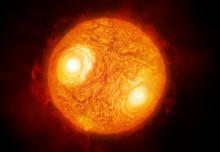Listen to today's episode of StarDate on the web the same day it airs in high-quality streaming audio without any extra ads or announcements. Choose a $8 one-month pass, or listen every day for a year for just $30.
You are here
Moon and Antares
The star Antares is orange. That means its surface is thousands of degrees cooler than the Sun’s. Deep inside, though, it’s a different story. The temperature in the core of Antares is at least 180 million degrees, compared to 27 million for the Sun.
Antares is hotter because it’s roughly a dozen times the mass of the Sun — and for a star, mass is everything. Gravity squeezes gas in the core tightly, making it hot enough to produce nuclear fusion. In the Sun, hydrogen atoms fuse together to make helium, releasing energy. As the energy radiates toward the surface, it pushes outward on the star’s surrounding layers of gas.
As a star’s mass increases, so does its gravity. It squeezes the core even tighter, making it even hotter. A hotter core “burns” the hydrogen more quickly, so it uses it up in a hurry. It then moves on to fusing the helium to make even heavier elements. Radiation from the hotter core causes the outer layers to puff up to amazing proportions. Antares, for example, is hundreds of times wider than the Sun. That makes its outer layers cooler and redder.
Antares should spend a total of about a million years in this phase of life before moving on to fuse other elements. When it can’t continue that process, the core will collapse and the outer layers will explode — sometime in the next million years.
Look for Antares close to the lower left of the Moon at nightfall, and a little closer as they set.
Script by Damond Benningfield




